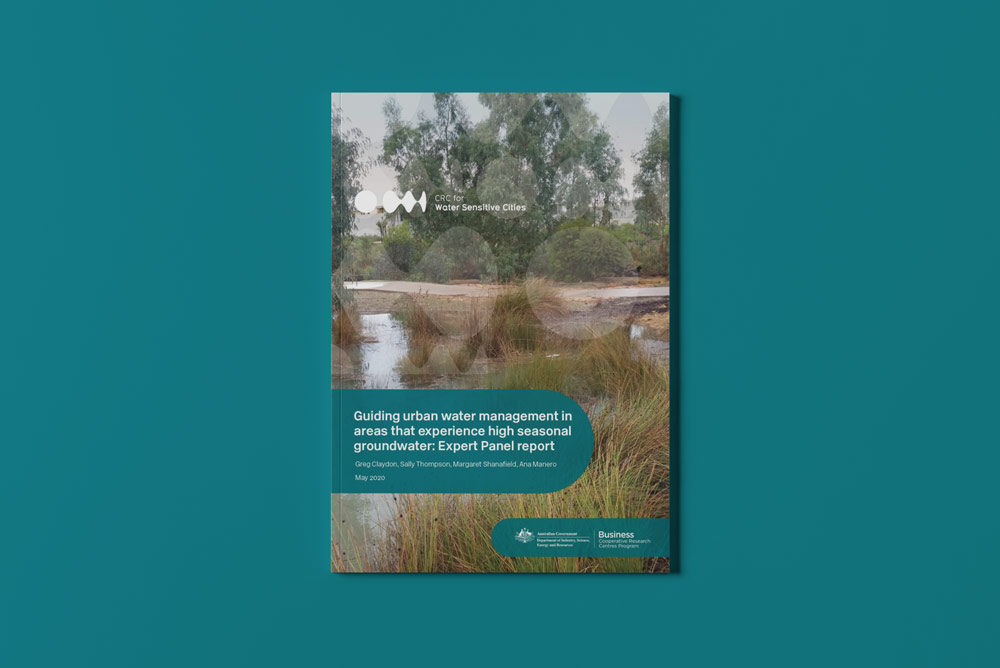Expert guidance for areas experiencing high seasonal groundwater
A significant part of our Integrated Research Project 5 (IRP5) – Knowledge-based water sensitive solutions for development in high groundwater environments – was to appoint an Expert Panel to provide technical guidance for planning and designing urban developments in high groundwater areas.
This guidance builds on practitioners’ and researchers’ experience and knowledge of the Swan Coastal Plain in Western Australia, as well as previous work by the CRCWSC and the Expert Panel’s own tacit knowledge and experiences. Part of the Panel’s remit was to also recommend further research, data and information collection or methods that may improve the guidance over time.
The Expert Panel has now released its guidance and recommendations in the report, Guiding urban water management in areas that experience high seasonal groundwater: Expert Panel report.

The Expert Panel’s guidance covers four key areas:
- Adopting a consistent risk-based framework to determine the level of pre-development site investigation, modelling and design evaluation that is appropriate for locations impacted by high groundwater. This framework is based on evaluation of the annual exceedance probabilities (AEPs) for the level of the water table and includes using:
- simplified (and potentially further improved) Controlled Groundwater Level (CGL) methods for low risk sites
- one-dimensional modelling methods (e.g. those based on the Hooghoudt equation) with enhancements for moderate risk sites
- two- or three-dimensional modelling methods (as the default without very strong justifications otherwise) for high risk sites.
These levels of risk are based on factors such as pre-development groundwater level (depth), pre-development land use/water quality, pre-development groundwater abstraction, soil type, receiving environments and other environmental constraints.
- Within this consistent risk-based framework, using consistent and coherent modelling approaches across the various planning levels and stages, with appropriate sensitivity analyses undertaken, and controls in place to ensure the assumptions and results can be followed through to implementation. The Expert Panel give guidance on a limited number of key influencing parameters, including for assisting initial ‘sense’ checks, while recognising the importance of appropriate site-based and case-based methodologies. Where deviations in modelling or assumptions, including parameter values, from earlier work are to occur or have occurred, justifications should be coherent, transparent, and supported, with any associated additional risks and cumulative impacts clearly identified.
- Demonstrating robust and resilient design and construction approaches, as an alternative approach to further refining modelling. This means adopting lot/sub-division/precinct/ drainage designs that can accommodate modelling error and/or other uncertainties. Various approaches are available and are being used or considered by experienced practitioners in Western Australia. These should be the subject of further demonstration and monitoring to evaluate their performance.
- Developing and having local governments use helpful technical assessment tools to facilitate their approval and compliance roles. These could include adopting existing or new/updated guidelines/approaches or parts thereof, checklists, identifying ‘red flags’ that indicate potential modelling or design problems, or numerical tools. State regulators should be involved in developing and adopting these tools to ensure consistency and coherence, and the urban development industry and their consultants should be involved in preparing them and assisting in their dissemination.
For more information about each guidance area, and the Expert Panel’s key findings and recommendations for future research, please download the report.
The CRCWSC is grateful for the input of the Expert Panel: Associate Professor Dr Sally Thompson from The University of Western Australia (UWA), Dr Margaret Shanafield from the National Centre for Groundwater Research and Training (Flinders University, Adelaide), and Greg Claydon (Chair, and CRCWSC Board Director), assisted by Research Associate Dr Ana Manero (UWA, Perth).
The Panel produced its report based on site visits, detailed discussions, and feedback on an earlier draft report from a range of Western Australia based urban development industry practitioners and consultants, local and state government officials and researchers. It consulted with the Urban Development Industry Association's Water Committee for WA, the multi-stakeholder Land Development in Groundwater Constrained Environments Steering Group (convened by the Institute of Public Works Engineering Australasia (WA branch) and the Western Australian Local Governments Association), the CRCWSC’s Western Region Advisory Panel, and Perth’s Water Sensitive Transition Network.
What happens next
Under IRP5, the Expert Panel’s review was work package 1. Now the IRP5 team will move on to work packages 2 and 3: Establishing field validation catchment and developing validation datasets.
In this phase, the team will work to fill the existing fundamental science gap. They will work directly with the Expert Panel and Project Steering Committee, to design a field program to test the assumptions highlighted in the panel’s guidance report.
This work will establish at least one field validation catchment, to determine how unsaturated zone dynamics control recharge, in urban areas impacted by high groundwater. In particular, the team will monitor key groundwater characteristics, to determine how urban development changes soil water storage and interflow dynamics, and thus recharge to, and discharge from, groundwater.
If you’d like to know more about IRP5, which is being led by Professor Carolyn Oldham from UWA, you can go here or contact Samantha Lemons (s.lemons@uq.edu.au).